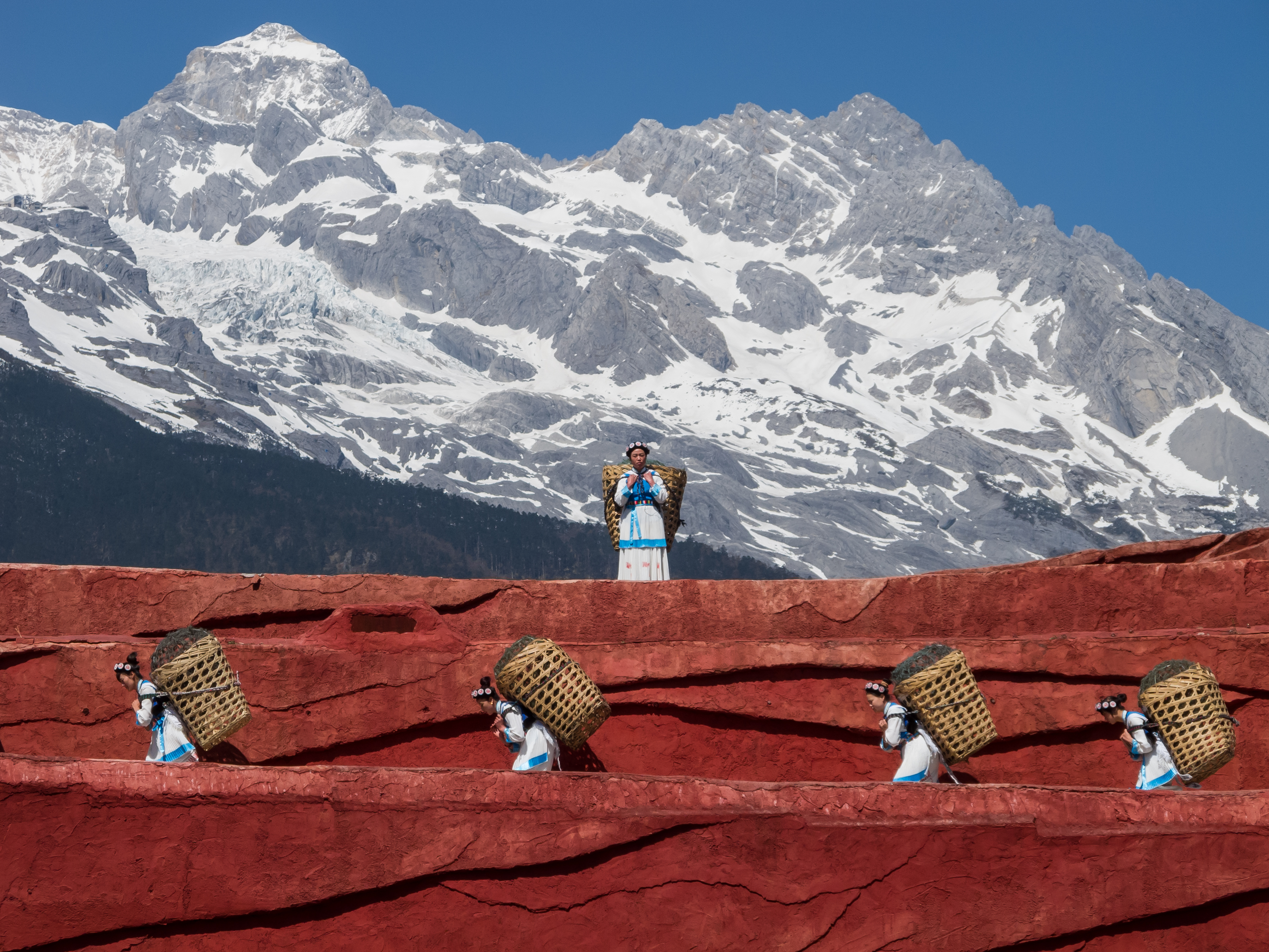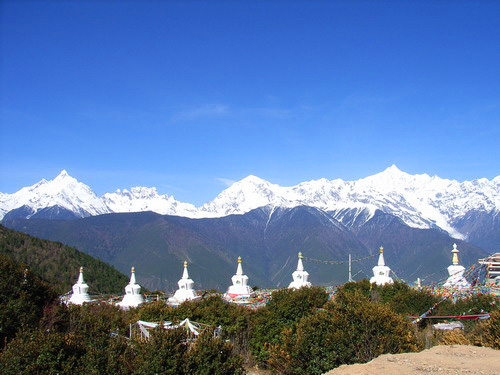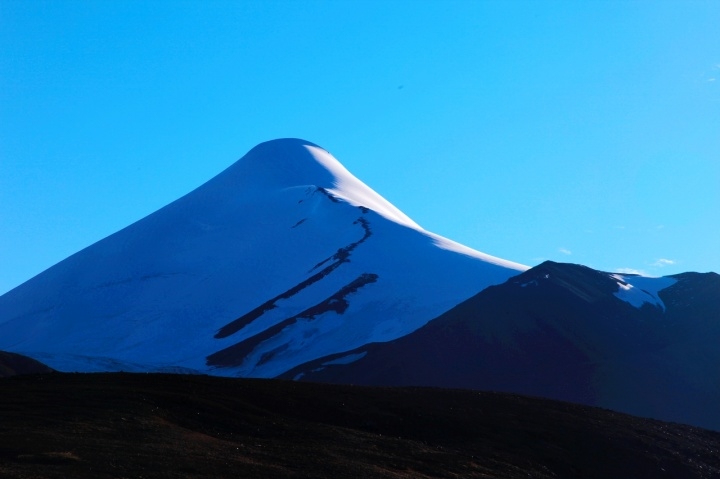|
Haba Xueshan
Haba Snow Mountain () is a mountain rising above the northwest side of Tiger Leaping Gorge in Yunnan, China. It rises opposite the higher Yulong Xueshan, and towers 3,500 metres above the upper reaches of the Yangtze River, also known as the Jinsha River. The summit of the mountain is a popular destination for amateur mountaineers and its lowest slopes are crossed by the popular Tiger Leaping Gorge trail. The Haba Snow Mountain massif is considered the southernmost extent of the expansive Shaluli Mountains, themselves a component range of the Hengduan Mountains. See also * Three Parallel Rivers of Yunnan Protected Areas - Unesco World Heritage Site * List of Ultras of Tibet, East Asia and neighbouring areas This is a list of all the Ultra prominent peaks (with topographic prominence greater than 1,500 metres) in Tibet, China, East Asia and neighbouring areas of Burma and India, including South India and Sri Lanka. Kunlun Mountains and Northeastern Ti ... References {{Yunnan ... [...More Info...] [...Related Items...] OR: [Wikipedia] [Google] [Baidu] |
Ultra Prominent Peak
An ultra-prominent peak, or Ultra for short, is a mountain summit with a topographic prominence of or more; it is also called a P1500. The prominence of a peak is the minimum height of climb to the summit on any route from a higher peak, or from sea level if there is no higher peak. There are approximately 1,524 such peaks on Earth. Some well-known peaks, such as the Matterhorn and Eiger, are not Ultras because they are connected to higher mountains by high cols and therefore do not achieve enough topographic prominence. The term "Ultra" originated with earth scientist Steve Fry, from his studies of the prominence of peaks in Washington (state), Washington in the 1980s. His original term was "ultra major mountain", referring to peaks with at least of prominence. Distribution Currently, 1,518 Ultras have been identified above sea level: 639 in Asia, 356 in North America, 209 in South America, 120 in Europe (including 12 in the Caucasus), 84 in Africa, 69 in Oceania, and 41 in ... [...More Info...] [...Related Items...] OR: [Wikipedia] [Google] [Baidu] |
Shangri-La County
Shangri-La (, Tibetan: Gyalthang) is a county-level city in Northwestern Yunnan Province, People's Republic of China and is the location of the seat of the Dêqên Tibetan Autonomous Prefecture, bordering Sichuan to the northwest, north, and east. Name Shangri-La was formerly called Zhongdian County () but was renamed on 17 December 2001 and upgraded into a county-level city on 16 December 2014 as Shangri-La (other spellings: Semkyi'nyida, Xianggelila, or Xamgyi'nyilha) after the fictional land of Shangri-La in the 1933 James Hilton novel ''Lost Horizon'', in an effort to promote tourism in the area. Formerly, the Tibetan population referred to the city by its traditional name Gyalthang or Gyaitang ( bo, རྒྱལ་ཐང།; Wylie: rgyal thang, ZWPY: Gyaitang), meaning "Royal plains". The Chinese name of the county seat, Jiantang (), reflects the pronunciation of Gyalthang. In the early morning of January 11, 2014, a fire broke out in the 1,000-year-old Dukezong Tibeta ... [...More Info...] [...Related Items...] OR: [Wikipedia] [Google] [Baidu] |
Yunnan
Yunnan , () is a landlocked Provinces of China, province in Southwest China, the southwest of the People's Republic of China. The province spans approximately and has a population of 48.3 million (as of 2018). The capital of the province is Kunming. The province borders the Chinese provinces of Guizhou, Sichuan, autonomous regions of Guangxi, and Tibet Autonomous Region, Tibet as well as Southeast Asian countries: Vietnam, Laos, and Myanmar. Yunnan is China's fourth least developed province based on disposable income per capita in 2014. Yunnan is situated in a mountainous area, with high elevations in the northwest and low elevations in the southeast. Most of the population lives in the eastern part of the province. In the west, the altitude can vary from the mountain peaks to river valleys by as much as . Yunnan is rich in natural resources and has the largest diversity of plant life in China. Of the approximately 30,000 species of Vascular plant, higher plants in China, Yu ... [...More Info...] [...Related Items...] OR: [Wikipedia] [Google] [Baidu] |
China
China, officially the People's Republic of China (PRC), is a country in East Asia. It is the world's most populous country, with a population exceeding 1.4 billion, slightly ahead of India. China spans the equivalent of five time zones and borders fourteen countries by land, the most of any country in the world, tied with Russia. Covering an area of approximately , it is the world's third largest country by total land area. The country consists of 22 provinces, five autonomous regions, four municipalities, and two Special Administrative Regions (Hong Kong and Macau). The national capital is Beijing, and the most populous city and financial center is Shanghai. Modern Chinese trace their origins to a cradle of civilization in the fertile basin of the Yellow River in the North China Plain. The semi-legendary Xia dynasty in the 21st century BCE and the well-attested Shang and Zhou dynasties developed a bureaucratic political system to serve hereditary monarchies, or dyna ... [...More Info...] [...Related Items...] OR: [Wikipedia] [Google] [Baidu] |
American Alpine Journal
The ''American Alpine Journal'' is an annual magazine published by the American Alpine Club. Its mission is "to document and communicate mountain exploration." The headquarters is in Golden, Colorado. Subtitled as a compilation of "The World's Most Significant Climbs," the magazine contains feature stories about notable new routes and ascents, written by the climbers, as well as a large "Climbs and Expeditions" section containing short notes by climbers about new and noteworthy achievements. Some general articles about mountaineering, mountain medicine, the mountain environment, or other topics are also sometimes included. Each issue includes book reviews, memorials of deceased members, and club activities. History The journal was established in 1929. In 1957 and 1958, the editor was Francis P. Farquhar. From 1960 to 1995, the editor was H. Adams Carter, who brought the journal to international pre-eminence. From 1996 to 2001, the editor was Christian Beckwith. Since 2002, the ed ... [...More Info...] [...Related Items...] OR: [Wikipedia] [Google] [Baidu] |
Tiger Leaping Gorge
Tiger Leaping Gorge () is a scenic canyon on the Jinsha River, a primary tributary of the upper Yangtze River. It is located north of Lijiang City, Yunnan in southwestern China. It is part of the Three Parallel Rivers of Yunnan Protected Areas World Heritage Site. Legend says the name comes from a hunted tiger escaping by jumping across the river at the narrowest point (still wide), using the rock in the middle. At a maximum depth of approximately 3,790 meters (12,434 feet) from river to mountain peak, Tiger Leaping Gorge is one of the deepest and most spectacular river canyons in the world. The inhabitants of the gorge are primarily the indigenous Nakhi people, who live in a handful of small hamlets. Their primary subsistence comes from grain production and nowadays hiking tourism. Geography left, Terraces partway up the sides of the Tiger Leaping Gorge Around in length, the gorge is located where the river passes between the Jade Dragon Snow Mountain and the Haba S ... [...More Info...] [...Related Items...] OR: [Wikipedia] [Google] [Baidu] |
Yulong Xueshan
Jade Dragon Snow Mountain (; Naxi: or ) is a mountain massif or small mountain range in Yulong Naxi Autonomous County, Lijiang, in Yunnan province, China. Its highest peak is named Shanzidou or Shan-Tzu-tou () and it is above sea level. Etymology The Chinese name, Yùlóng Xuěshān, translates directly as Jade Dragon Snow Mountain; it is sometimes translated as Mount Yulong or Yulong Snow Mountain. The mountain's Naxi name is Mount Satseto. Geography The Jade Dragon Snow Mountain massif forms the bulk of the larger Yulong Mountains, that stretch further north. The northwestern flank of the massif forms one side of the Tiger Leaping Gorge (Hǔtiào Xiá, 虎跳峡), which has a popular trekking route on the other side. In this gorge, the Jinsha (upper Yangtze) River descends dramatically between Jade Dragon and Haba Snow Mountain. The Yulong Mountains lie to the south of the Yun Range and are part of Southwest China's greater Hengduan Mountains. Settlements surro ... [...More Info...] [...Related Items...] OR: [Wikipedia] [Google] [Baidu] |
Yangtze River
The Yangtze or Yangzi ( or ; ) is the longest list of rivers of Asia, river in Asia, the list of rivers by length, third-longest in the world, and the longest in the world to flow entirely within one country. It rises at Jari Hill in the Tanggula Mountains (Tibetan Plateau) and flows in a generally easterly direction to the East China Sea. It is the List of rivers by discharge, seventh-largest river by discharge volume in the world. Its drainage basin comprises one-fifth of the land area of China, and is home to nearly one-third of the demographics of China, country's population. The Yangtze has played a major role in the history of China, history, culture of China, culture, and economy of China. For thousands of years, the river has been used for water, irrigation, sanitation, transportation, industry, boundary-marking, and war. The prosperous Yangtze Delta generates as much as 20% of historical GDP of China, China's GDP. The Three Gorges Dam on the Yangtze is the list ... [...More Info...] [...Related Items...] OR: [Wikipedia] [Google] [Baidu] |
Shaluli Mountains
The Shaluli Mountains (), known in Standard Tibetan, Tibetan as Powor Gang, are a large mountain range in western China between the Upper Yangtze (Jinsha) and Yalong River, Yalong Rivers. It is one of the core ranges of the Hengduan Mountains, Hengduan group of mountains. The Shaluli Mountains stretch over 500 km from Dege County, Sichuan in the north to Shangri-La County, Yunnan in the south. The highest peak of the range is Ge'nyen Massif at above sea level. Other subranges in the Shaluli Mountains include the Chola Mountains to the north, the Zhaga Mountains to the east, the Yading massif in the south, and Haba Snow Mountain at the southern edge of the range. The Shaluli Mountains were historically part of the Kham region of Tibet and are now mostly administered as part of Garze Prefecture in modern-day Sichuan Province. Litang County, Litang is the major population centre in this mountain region. The major peaks of the range outside of the Chola Mountains include: *G ... [...More Info...] [...Related Items...] OR: [Wikipedia] [Google] [Baidu] |
Three Parallel Rivers Of Yunnan Protected Areas
The Three Parallel Rivers of Yunnan Protected Areas () is a UNESCO World Heritage Site in Yunnan province, China. It lies within the drainage basins of the upper reaches of the Jinsha (Yangtze), Lancang (Mekong) and Nujiang (Salween) rivers, in the Yunnan section of the Hengduan Mountains. Overview Geography The protected areas extend over 15 core areas, totalling 939,441.4 ha, and buffer areas, totalling 758,977.8 ha across a region of 180 km by 310 km. Here, for a distance of over 300 km, three of Asia's great rivers run roughly parallel to one another though separated by high mountain ranges with peaks over 6,000 meters. After this area of near confluence, the rivers greatly diverge: the Nujiang River becomes Salween and empties out at Moulmein, Burma, into the Indian Ocean, the Lancang becomes the Mekong and south of Ho Chi Minh City, Vietnam, empties out into the South China Sea and the Yangtze flows into the East China Sea at Shanghai. Selected n ... [...More Info...] [...Related Items...] OR: [Wikipedia] [Google] [Baidu] |
List Of Ultras Of Tibet, East Asia And Neighbouring Areas
This is a list of all the Ultra prominent peaks (with topographic prominence greater than 1,500 metres) in Tibet, China, East Asia and neighbouring areas of Burma and India, including South India and Sri Lanka. Kunlun Mountains and Northeastern Tibet Plateau Western Tibet and neighboring areas South-eastern Tibet and neighboring areas Yunnan Daxue Mountains of Sichuan Contiguous Eastern China Taiwan and Hainan South India and Sri Lanka , References External links E. Jurgalski and others:List of Ultras in Tibet * [...More Info...] [...Related Items...] OR: [Wikipedia] [Google] [Baidu] |
.jpg)




